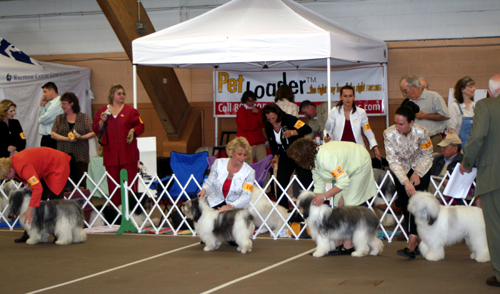| |
- After the judge stops the line, he will individually examine each dog.
"Stack" your PON and step back as the judge approaches him. Do not
drop the leash. Answer all of the judge's questions, such as if the PON
"bites," his age, etc. He may ask you to show him the PON'S teeth. Listen
carefully. Do not volunteer additional information.
- When the judge has checked your PON'S physical structure completely,
he will want you to gait your PON. Please listen as he tells you where to go,
and if you do not understand, ask him again. Watch those who are
sent out before you. Judges vary on how to efficiently view gait. Know the
different patterns, and practice them in handling class.
- When you return to the judge, he may send you out again, instructing
you to go faster or slower, or in a different pattern. He may be looking
for something special in the PON gait.
- Most judges will stop you as you bring your PON back from the
gaiting with a wave of their hand. Stop quickly and alert your PON. The
judge is trying to determine the PON'S "expression." This is an important
moment for most judges.
- When the judge is through with your PON, and beckons to the next one,
go to the end of the line, "stack" your dog, and try to keep him looking
his very best as the judge goes over the other PONS. Most judges will look
back from time to time, mentally comparing the PONS. Don't allow an early
impression to be lost by allowing your PON to become distracted or act up at this
time.
- After going over all the PONS in the class, the judge will probably
send all the dogs together around in a final circle, and then make his
selections. If you are in the first four placings, go to the placing so
indicated and take your ribbon, thank the judge and leave the ring.
First and second place winners stand by for possible further judging.
- Remember that the well-trained PON has the advantage in that he
shows the judge his very best points, rather than making the judge
come and look for them.
|
|

